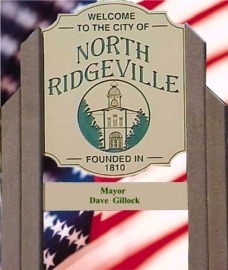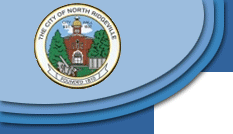
A BRIEF HISTORY OF NORTH RIDGEVILLE
(Founded 1810)
Jeff Sigsworth, President
NORTH RIDGEVILLE HISTORICAL SOCIETY
March 12, 2004
The first permanent
settlement in North Ridgeville (originally called Ridgeville
Township) took place on May 10, 1810, when 14 men from
Waterbury, Conn.
(mostly members of the Terrell and Beebe
families),
together with 3 other
men (also relatives) who had come
to nearby Columbia Township in 1809,
entered Ridgeville on
foot
from the southeast - stopping at present-day
Bainbridge
Road, where they soon built the first log building in the
township.
Three of these original 17 pioneers were Revolutionary
War veterans; and
one, 80-year-old Oliver Terrell, had been
a
soldier in the French & Indian War.
Several more settlers
and family members arrived later in 1810, including
Mrs. Electa
(Wilmot) Terrell - the first pioneer woman living in this
settlement,
in the wilderness of Connecticut's Western Reserve.
Ridgeville Township was
divided by five geological ridges
(hence the name), which in prehistoric times
were the shorelines
of the receding Lake Erie - created by the slow northward
migration of massive Ice Age glaciers. Wild animals (wolves,
bears, deer, etc.),
migratory native American Indians, and
later the New England pioneers,
traveled along the higher
sandy ridges - looking for food, water, and shelter.
Between
these ridges were the rich swampy (wetland) areas, where dense
forests, wild cranberries and rattle-snakes thrived. The first
log homes in
Ridgeville were built along the eastern end of
Center Ridge, and along
Butternut Ridge (Lorain Road); but,
as the wetlands were drained and the
trees cleared, farms
and cabins or frame homes were established all over
town.
In 1813, the settlement's adult male citizens (15 voters)
approved the
creation of Ridgeville Township, which existed
for 145 years. The men of the
township joined the Ohio militia,
and served at the Columbia Blockhouse (along
with others from
Columbia, Eaton, and Middleburg Townships) during the
War
of 1812 - which lasted until 1815.
It was said that during
the
Battle of Lake Erie (September, 1813), the
occupants
of the blockhouse could
hear distinctly the cannon fire between
Perry's victorious fleet and the British
forces, near Put-in-Bay.
In 1829, due to frequent mail mix-ups with another
Ridgeville
(near Dayton,
Ohio), the Postmaster General requested
that we
change the name of our post
office to "North Ridgeville." Thereafter, the
community around the intersection
of Center Ridge Road (now State Route
113 and U.S. Route 20) and Center
Road
or Station Road (later called
Avon-Belden Road, State Route 76, and
State Route
83) was known as "Ridgeville Center" (or North Ridgeville P.O.).
Early churches
were established
in 1822 on Center Ridge (Presbyterian/ Congregational, now the
First Congregational U.C.C.); 1825 on Butternut Ridge (Methodist Episcopal,
now
called Fields United Methodist); and 1875 (St. Peter
Roman Catholic). Ten
district
schools throughout the township were built in the 1850's (replacing
the few log
buildings constructed earlier). The first businesses
in Ridgeville
Township (grist
mill, saw mill, quarries, cheese factories) were later
supplemented by blacksmith
shops, general stores and a chair factory.
Stagecoach lines followed Center Ridge
and Butternut Ridge from the late
1820's until (or after) the opening of the
steam railroad through
Ridgeville in
1853 (for many years known as the Lake Shore & Michigan Southern
R.R.,
and then the New York Central R.R.). Two stagecoach inns are still standing.
Many German and English settlers came to Ridgeville in the 1840's and 1850's.
A small community, "Shawville," complete with general store, post office, and
railroad station, grew up at the Station Road (Avon-Belden Road) railroad
crossing;
another community at Root Road and Butternut Ridge was first
called "Briggs'
Corners," and after 1881, "Fields Corners." The Cleveland &
Southwestern electric
interurban (trolley) tracks were built through
Ridgeville Township in 1895 (along
the south side of Center Ridge Road),
connecting Cleveland and Ridgeville with
other towns to the west and south -
until the system was finally disbanded in
1931, surpassed by automobiles,
trucks, buses and airplanes.
The predominantly
farming nature of Ridgeville
Township lasted through the
post-World War II population
boom, and the
1958 creation of the Village of
North Ridgeville; and past the
1960
organization of the City of North Ridgeville -
extending until the first
great "spurt" of the area's growth in the 1960's and
1970's. Now, in the 21st
Century, with greatly-increased
population (and
automobile traffic), modern
streets & highway access, bridges,
schools,
and
many more industries,
businesses & housing developments, the people
of North Ridgeville enjoy
benefits (and challenges) never dreamed of by the 1810
pioneers.
